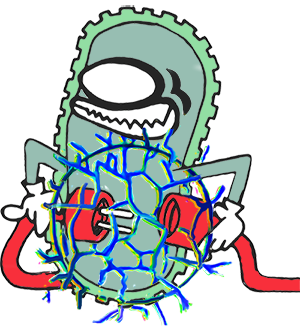Team:TU Delft-Leiden/Modeling/EET
From 2014.igem.org
EET Module
In the wet lab, we integrated the extracellular electron transport (EET) module of S. oneidensis into E. coli , see the extracellular electron transport (EET) module. For the modeling of the EET module, we wanted at first to gain insight in the consequences of the integration of the EET module into E. coli. To achieve this, we had to find a way to simulate the cell metabolism of E. coli including the EET module. Flux Balance Analysis (FBA) is a method that calculates the fluxes of metabolites through a metabolic network, more about the theory of Flux Balance Analysis can be found in Flux Balance Analysis Method. Therefore, we decided to use the FBA method to gain insight in the resulting cell metabolism of E. coli. Our goal was to investigate the carbon metabolism providing the electrons for the EET module, as described in Carbon Metabolism and Electron Transport. Also, we want the EET pathway used by the cells in order to have a measurable electrical signal for our biosensor, see the gadget section of our wiki.
The results can be found in Flux Balance Analysis of the EET Module.
The EET protein complex consists of three proteins: MtrA, a cytochrome on the inside of the outer membrane, MtrB, a β-barrel protein located in the outer membrane, and MtrC, another cytochrome, located on the cell surface. This complex enables the cell to transport electrons from the cytoplasm of the cell to the extracellular environment.
The assembly of the trans-membrane EET complex depends on many factors other than transcriptional and translational control, as it requires a large amount of post-translational modifications. We will set up a simplified model of this assembly process, largely based on section 1.3 of the thesis of Jensen[1]. With the use of deterministic modeling, our goal is to predict how many EET complexes are formed under different initial conditions. More about the theory of deterministic modeling can be found in Deterministic Modeling Methods.
In our modeling of the assembly of the EET complex, we will, in addition to the assembly mechanism, also focus on the apparent reduced cell viability. Jensen proposes two possible explanations for this: the formation of cytosolic aggregates and reduced membrane integrity due to the high amount of trans-membrane protein complexes [1].
The results can be found in Deterministic Model of EET Complex Assembly.
References
[1] H.M. Jensen, “Engineering Escherichia coli for molecularly defined electron transfer to metal oxides and electrodes”, PhD Thesis Chemistry UC Berkeley, 2013.
 "
"






